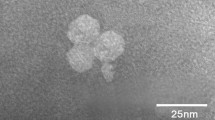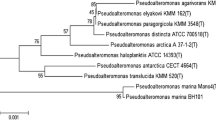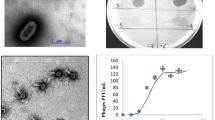Abstract
Cyanophages are ubiquitous and essential components of the aquatic environment and play an important role in the termination of algal blooms. As such, they have attracted widespread interest. PP was the first isolated cyanophage in China, which infects Plectonema boryanum and Phormidium foveolarum. In this study, this cyanophage was purified three times by a double-agar overlay plaque assay and characterized. Its genome was extracted, totally sequenced and analyzed. Electron microscopy revealed a particle with an icosahedral head connected to a short stubby tail. Bioassays showed that PP was quite virulent. The genome of PP is a 42,480 base pair (bp), linear, double-stranded DNA molecule with 222 bp terminal repeats. It has high similarity with the known Pf-WMP3 sequence. It contains 41 open reading frames (ORFs), 17 of which were annotated. Intriguingly, the genome can be divided into two completely different parts, which differ both in orientation and function.
Similar content being viewed by others
References
Bergh O, Borsheim K Y, Bratbak G, et al. 1989. High abundance of viruses found in aquatic environments. Nature, 340: 467–468.
Bratbak G, Heldal M, Norland S, et al. 1990. Viruses as partners in spring bloom microbial trophodynamics. Appl Environ Microbiol, 56(5): 1400–1405.
Bryan M J, Burroughs N J, Spence E M, et al. 2008. Evidence for the intense exchange of MazG in marine cyanophages by horizontal gene transfer. PloS One, 3(4): e2048.
Carmichael W W. 2001. Health effects of toxin-producing Cyanobacteria: “The CyanoHABs”. Hum Ecol Risk Assess, 7(5): 1393–1407.
Chenard C, and Suttle C A. 2008. Phylogenetic diversity of sequences of cyanophage photosynthetic gene psbA in marine and freshwaters. Appl Environ Microbiol, 74(17): 5317–5324.
Chen F, and Lu J R. 2002. Genomic sequence and evolution of marine Cyanophage P60: a new insight on lytic and lysogenic phages. Appl Environ Microbiol, 68(5): 2589–2594.
Codd G A, Morrison L F, and Metcalf J S. 2005. Cyanobacterial toxins: risk management for health protection. Toxicol Appl Pharmacol, 203: 264–272.
Dittmann E, and Wiegand C. 2006. Cyanobacterial toxins-occurrence, biosynthesis and impact on human affairs. Mol Nutr Food Res, 50: 7–17.
Fuhrman J A. 1999. Marine viruses and their biogeochemical and ecological effects. Nature, 399: 541–548.
Gao E B, Gui J F, and Zhang Q Y. 2012. A novel cyanophage with cyanobacterial non-bleaching protein A gene in the genome. J Virol, 86(1): 236–245.
Jungblut A D, Hawes I, Mountfort D, et al. 2005. Diversity within cyanobacterial mat communities in variable salinity meltwater ponds of McMurdo Ice Shelf, Antarctica. Environ Microbiol, 7(4): 519–529.
Kropinski A M, Mazzocco A, Waddell TE, et al. 2009. Enumeration of bacteriophages by double agar overlay plaque assay. Methods Mol Biol, 501: 69–76.
Liao M J, Cheng K, Yang J Y, et al. 2010. Assessment of UV-B damage in cyanophage PP. Aquat Microb Ecol, 58: 323–328.
Liu X Y, Shi M, Kong S L, et al. 2007. Cyanophage Pf-WMP4, a T7-like phage infecting the freshwater cyanobacterium Phormidium foveolarum: Complete genome sequence and DNA translocation. Virology, 366: 28–39.
Liu X Y, Kong S L, Shi M, et al. 2008. Genomic analysis of freshwater cyanophage Pf-WMP3 infecting cyanobacterium Phormidium foveolarum: the conserved elements for a phage. Microb Ecol, 56: 671–680.
Lorraine C B. 2002. Cyanobacterial Harmful Algal Blooms (CyanoHABs): Developing a public health response. Lake Reserv Manag, 18(1): 20–31.
Mann N H, Clokie M R J, Millard A, et al. 2005. The genome of S-PM2, a “photosynthetic” T4-type bacteriophage that infects marine Synechococcus strains. J Bacteriol, 187(9): 3188–3200.
Paul J H, and Weinbauer M. 2010. Detection of lysogeny in marine environments. In Wilhelm S W, Weinbauer M G, and Suttle C A (eds), Manual of Aquatic Viral Ecology, pp 30–33, American Society of Limnology and Oceanography, TX, USA.
Pope W H, Weigele P R, Chang J, et al. 2007. Genome sequence, structural proteins, and capsid organization of the cyanophage Syn5: a “horned” bacteriophage of marine Synechococcus. J Mol Biol, 368: 966–981.
Proctor L M, and Fuhrman J A. 1990. Viral mortality of marine bacteria and cyanobacteria. Nature, 343: 60–62.
Raytcheva D A, Haase-Pettingell C, Piret J, et al. 2011. Intracellular assembly of cyanophage Syn5 proceeds through a scaffold-containing procapsid. J Virol, 85(5): 2406–2415.
Sabehi G, Shaulov L, Silver D H, et al. 2012. A novel lineage of myoviruses infecting cyanobacteria is widespread in the oceans. Proc Natl Acad Sci U S A, 109(6): 2037–2042.
Safferman R S, and Morris S E. 1963. Algal virus: isolation. Science, 140(3567): 679–680.
Safferman R S. 1983. Classification and nomenclature of viruses of cyanobacteria. Intervirology, 19: 61–66.
Sherman L A, Haselkorn R. 1970. LPP-1 infection of the blue-green alga Plectonema boryanum: I. Electron Microscopy. J Virol, 6(6): 820–833.
Sullivan M B, Coleman M L, Weigele P, et al. 2005. Three Prochlorococcus cyanophage genomes: signature features and ecological interpretations. PloS Biol, 3(5): e144.
Sullivan M B, Krastins B, Hughes J L, et al. 2009. The genome and structural proteome of an ocean siphovirus: A new window into the cyanobacterial ‘mobilome’. Environ Microbiol, 11: 2935–2951.
Suttle CA. 2005. Viruses in the sea. Nature, 437: 356–361.
Suttle CA. 2007. Marine viruses-major players in the global ecosystem. Nat Rev Microbiol, 5: 801–812.
Weigele P R, Pope W H, Pedulla M L, et al. 2007. Genomic and structural analysis of Syn9, a cyanophage infecting marine Prochlorococcus and Synechococcus. Environ Microbiol, 9: 1675–1695.
Wilhelm S W, Carberry M J, Eldridge M L, et al. 2006. Marine and freshwater cyanophages in a Laurentian Great Lake: evidence from infectivity assays and molecular analyses of g20 genes. Appl Environ Microbiol, 72(7): 4957–4963.
Wilson W H, Joint L R, Carr N G, et al. 1993. Isolation and molecular characterization of five marine cyanophages propagated on S ynechococcus sp. strain WH7803. Appl Environ Microbiol, 59: 3736–3743.
Yoshida M, Yoshida T, Kashima A, et al. 2008. Ecological dynamics of the toxic bloom-forming cyanobacterium Microcystis aeruginosa and its cyanophages in freshwater. Appl Environ Microbiol, 74(10): 3269–3273.
Yoshida T, Nagasaki K, Takashima Y, et al. 2008. Ma-LMM01 infecting Microcystis aeruginosa illuminates diverse cyanophage genome strategies. J Bacteriol, 190(5): 1762–1772.
Zhao Y J, Chen K, Shi Z L, et al. 2002. Isolation and identification of the first cyanophage in China. Prog Nat Sci, 12: 923–927. (In Chinese)
Author information
Authors and Affiliations
Corresponding author
Rights and permissions
About this article
Cite this article
Zhou, Y., Lin, J., Li, N. et al. Characterization and genomic analysis of a plaque purified strain of cyanophage PP. Virol. Sin. 28, 272–279 (2013). https://doi.org/10.1007/s12250-013-3363-0
Received:
Accepted:
Published:
Issue Date:
DOI: https://doi.org/10.1007/s12250-013-3363-0




